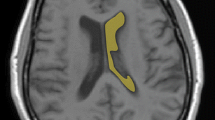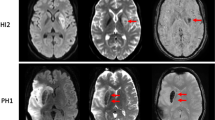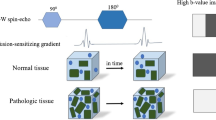Abstract
We investigated the usefulness of echo-planar imaging (EPI) as well as T2*-weighted and diffusion-weighted MRI (DWI) to identify hyperacute hemorrhage (within 24 h after ictus) in the brain. Seven patients were examined 3.5 to 24 h after onset of symptoms using a whole-body 1.5-T MR system. Two diffusion-weighted sequences were run to obtain isotropic and anisotropic diffusion images. Apparent diffusion coefficients (ADC) were calculated from the isotropic diffusion images. All DWI images as well as the T2*-weighted EPI images showed the hematomas as either discrete, deeply hypointense homogeneous lesions, or as lesions of mixed signal intensity containing hypointense areas. We conclude that even in the early phase after hemorrhage, sufficient amounts of paramagnetic deoxyhemoglobin are present in intracerebral hemorrhages to cause hypointensity on EPI T2*-weighted and DWI images; thus, use of ultrafast EPI allows identification of intracerebral hemorrhage.
Similar content being viewed by others
Author information
Authors and Affiliations
Additional information
Received: 21 March 2000 Revised: 26 July 2000 Accepted: 27 July 2000
Rights and permissions
About this article
Cite this article
Wiesmann, M., Mayer, T., Yousry, I. et al. Detection of hyperacute parenchymal hemorrhage of the brain using echo-planar T2*-weighted and diffusion-weighted MRI. Eur Radiol 11, 849–853 (2001). https://doi.org/10.1007/s003300000649
Issue Date:
DOI: https://doi.org/10.1007/s003300000649




